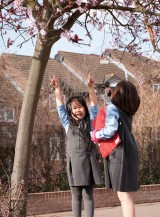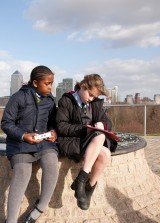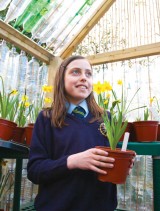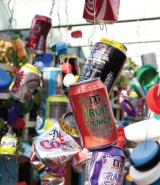Outdoor learning doesn't have to be grand or expensive to be effective, as Joe Carter discovered at St John's Catholic Primary School...
There’s nothing revolutionary about the lesson taking place outside St. John’s Catholic Primary School in Rotherhithe.It’s early March and a clear, bright morning has interrupted four days of solid rain, drawing Y1 pupils out into the weak sunlight to search for early signs of spring. Peering through magnifying glasses, they examine and sketch the leaves and flowers found bordering the playground.
 Each child has a sheet of photographs displaying a variety of flora and fauna, and they buzz from one plant to the next, eager to find living examples. Just stepping outside the classroom has introduced an air of excitement; is this learning or playtime?
Each child has a sheet of photographs displaying a variety of flora and fauna, and they buzz from one plant to the next, eager to find living examples. Just stepping outside the classroom has introduced an air of excitement; is this learning or playtime?
Pupils up and down the country will be recreating this very lesson, so how is it that St John’s managed to win the Council for Learning Outside the Classroom’s award for best primary provision in 2011? At first glance, it seems an unlikely candidate. The school stands in the shadow of Canary Wharf, is within walking distance of the Thames and has little in the way of green spaces – at least on site. Surely a primary nestled in a leafy suburban village would be favourite to pick up this al fresco accolade?
But what must have caught the judges’ eyes was not one or two showcase events, rather the consistency and commitment that St John’s applies to outdoor education. Any opportunity to take children beyond the confines of the classroom is seized upon, particularly if it can be done at minimal expense. Deputy head, Vera Jajechnyk, in particular, always has an eye out for a bargain. Just last week she snapped up a deal for Y5 and Y6 to see a gospel choir perform at the Royal Festival Hall. “The tickets were £3 each, you can’t really pass that up,” is her simple explanation. And while the experience of watching the choir is certain to live long in children’s memories, the benefits of the trip do not begin and end at the theatre. “When we come back to school there will be the chance for the children to take part in workshops,” says Vera. “I am hoping there will be songs that older children can teach to the rest of the school. The plan is to start using gospel music in our assemblies.”
 Of course, not every school has the Royal Festival Hall on its doorstep and what St John’s lacks in green spaces it more than makes up for in terms of access to the arts. There have been visits to the Tower of London, National Portrait Gallery and London Zoo to name but a few. But these grand days out are interspersed with more humble experiences. For over 15 years, Vera has been taking her class to workshops at Pizza Express, having spotted a newspaper ad promoting free sessions for schools. “Some restaurants in the chain offer the workshops and some don’t, so you might need to ring round a few quite a bit in advance,” she advises. “There used to be a fantastic manager at London Bridge who would do restaurant maths with the children and let them make the pizza dough, although that was quite a while ago. Now they give you the dough ready-made in in the pan, which is a shame, but it’s still something for nothing.”
Of course, not every school has the Royal Festival Hall on its doorstep and what St John’s lacks in green spaces it more than makes up for in terms of access to the arts. There have been visits to the Tower of London, National Portrait Gallery and London Zoo to name but a few. But these grand days out are interspersed with more humble experiences. For over 15 years, Vera has been taking her class to workshops at Pizza Express, having spotted a newspaper ad promoting free sessions for schools. “Some restaurants in the chain offer the workshops and some don’t, so you might need to ring round a few quite a bit in advance,” she advises. “There used to be a fantastic manager at London Bridge who would do restaurant maths with the children and let them make the pizza dough, although that was quite a while ago. Now they give you the dough ready-made in in the pan, which is a shame, but it’s still something for nothing.”
The Apple Store in Regent Street has provided another thrifty outing. “They treated the children brilliantly,” says Vera. “They gave them all T-shirts, which hooked them in straight away. The children sat in a theatre space and worked in pairs on iMacs, which they were over the moon about. They made lovely photographic presentations and these were shown on a big screen at the end of the session while the children’s projects were being burnt onto CDs.”
St John’s opportunistic approach to outdoor learning is, in part, due to the rising price of travel. Many teachers will know the frustration of failing to get a school trip off the ground because of the prohibitive cost of coaches. For Vera, the numbers just don’t add up. “We used to take Y6 out for the day to do something exciting in the summer,” she recalls. “But coach costs were about £600 and this year we only have 22 in the class. You can’t split £600 between 22 children and then add the cost of the trip on top of that.” The alternative? Public transport.
Faced with the prospect of taking 30 seven year-olds onto a London bus, many teachers’ first instinct might be to call a good lawyer, but the staff at St John’s are fairly casual about travelling in this fashion. The fear factor is reduced as children use the bus and tube from a young age and so the correct behaviour quickly becomes second nature.
When Y1 teacher Liz Jack was reading Momma Panya’s Pancake – the tale of a mother and son sourcing ingredients in a Kenyan village – she thought nothing of taking a bus ride with the children to Deptford market. Herself a local, Liz spoke to the market traders the day before the visit so they would be prepared for the pupils’ arrival. “They were all friendly and willing to help,” she explains. “The people who run the fish stall showed the children some really big fish. They were all screaming! We were given fruit to try as well and when we got back to the classroom we made fruit salad.”
 That afternoon, KS2 children at St John’s are making use of another local resource: the Russia Dock Woodlands. Armed with sound meters, the pupils file out into the long narrow park, which is conveniently accessed through a gate at the back of the school. Thewoods were created by the infilling of one of the former docks and sit next to Stave Hill, a high point from which Canary Wharf and the surrounding area can be surveyed.
That afternoon, KS2 children at St John’s are making use of another local resource: the Russia Dock Woodlands. Armed with sound meters, the pupils file out into the long narrow park, which is conveniently accessed through a gate at the back of the school. Thewoods were created by the infilling of one of the former docks and sit next to Stave Hill, a high point from which Canary Wharf and the surrounding area can be surveyed.
The lesson is due to start at the top of the hill. On route, the children are talkative and excitable, but once the activitybegins they fall silent and listen intently, recording the sound levels.
Again, the lesson isn’t showy, but it demonstrates how frequently children are given the chance to develop their skills in the outdoor classroom. The woodlands have hosted countless activities: taking and editing wildlife photography; producing films about the area’s natural beauty; monitoring the changing seasons. Pupils also work to develop Russia Dock with Rebeka Clark, site manager at Stave Hill Ecology Park. She invites them to take part in the planting of new trees, and they have recently enjoyed decorating bird boxes for the area with pictures and helpful messages, such as ‘Birds. Please come back here!’. Once a site for vandalism, these activities are intended to help children form an lasting connection with the woods.
“Putting a focus on outdoor learning was never anything we sat down and planned,” reflects Vera. “When we applied for the CLOtC award, my class counted up how many outdoor activities they could remember doing over the year. It came to over 40, which was quite surprising.”
The way in which St John’s status as a leader in outdoor learning has crept up on staff is an indication of just how natural it has become. And it’s precisely the routine nature of taking lessons outside that makes them so special.
1. London 2012
Pupils in Y6 spent the day in the ‘View Tube’, a fantastic classroom that overlooks the Olympic site, where they took part in a session about why Stratford was chosen and the legacy that will be left behind after the games. After this, children headed to Westfield Shoppingcentre to interview members of the public. Nervous at first, they soon got into the swing of it, asking shoppers about from where they had travelled from, and whether or not they were looking forward to the Olympics. Answers were recorded and the children also counted the numberof people who walked in and out of the shopping centre in a five-minute period so the data could be used back in the classroom.
2. 1,500 ‘Green’ bottles
Over a period of three weeks, pupils collected 1,500 plastic bottles, which were used to build the greenhouse that now stands in the playground. Bottles were procured from neighbours and even the local pubs and a group of volunteers came in to build the structure. It’s currently being used to grow daffodils as part of the Marie Curie Pots of Care campaign.
 3. Rubbish music
3. Rubbish music
A musician came to visit the school and filled half the hall with instruments made from recycled junk, from bits of cars to old kitchen utensils. The children crowded in and enjoyed a concert before going outside to build their own music area from waste. Theydrilled holes in pipes so they could be attached to the walls as xylophones and hung big baked bean cans from the small staging areas – often used for drama – that line the side of the playground.
Make World Book Day Extra Special This Year
Ace-English
How to use modelling to engage pupils with autism
Ace-Art-And-Design
